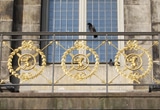 When the French invaded the Netherlands at the end of the 18th century, we were not yet a kingdom, and we were, in fact, a republic, I believe. The Frogs did as they pleased and dismissed our frail democratic government.
When the French invaded the Netherlands at the end of the 18th century, we were not yet a kingdom, and we were, in fact, a republic, I believe. The Frogs did as they pleased and dismissed our frail democratic government.
For long, our nation had been divided by those who adhered to the family of Orange (ancestors to our present royal family) and so-called patriots who favoured a government along the lines of the French and American revolutions.
Well, neither won; we got for our very first king nobody else than Lodewijk Napoleon from Sicily, the emperor’s younger brother. His rule lasted no longer than four years as his brother sacked him for spoiling us. He was called Lodewijk de Goede, Goede meaning good one. He was also called the Lamme as he was Lame.
After his imperial majesty emperor, Napoleon Bonaparte appointed the “first” king of The Netherlands, his irritating brother Louis to get him out of his hair; Louis looked for a place to live in his new kingdom. He took an instant liking to that “building” on Dam square and moved in.
The building was already in use and had a legitimate purpose; functioning as the town hall did not bother him. He thought that the grandeur of the building belonged to the ruler of such a glorious new kingdom of the Netherlands.
He even had a balcony placed at the front of the new palace; it still serves the royal family today as when on rare occasions, one of them wishes to marry in Amsterdam.
In 1810 The Netherlands became a “department” of France; we no longer needed a king, so Lodewijk had learned Dutch for nothing was deposed and called home. Now, they say that what goes around comes around and in 1813 it was Napoleon Bonaparte, the Emperor himself, who got deposed and banished.
“But,” we were now a kingdom!
We even had a palace; all we needed was a king!
The nation’s second king (Willem I) graciously returned the building to the city but guess what? They didn’t want it anymore.
Things had not gone well in Amsterdam; the wealth it once had was depleted, its coffers were empty, and the palace was an expensive building to maintain.
They leant it out to the state (for free, I believe) to use at their pleasure and pay for its upkeep.
The king was touched and gave Amsterdam the right to call itself the capital city of the Netherlands.
It would take another 120 years before Amsterdam would finally officially sell the building off to the state.

The pictures on this page are courtesy of the website of the Royal Palace; click HERE. To go to their website.
Some say that the palace should once more revert to the city and become its town hall again. Now that’s no longer possible
as the state has finally become its sole owner, we sold it to the national government, and we can no longer lay any claim to it.
The deal made by Willem I gave us the national title. We want to stay in the capital, and you better believe it!
The town hall on Dam square is window number 17 on the Canon of Amsterdam.
The Royal Palace on Dam square is window number 24 on the Canon of Amsterdam.